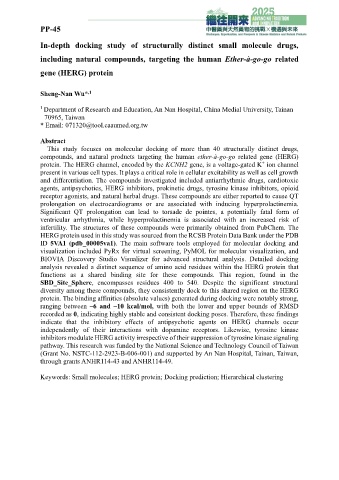Page 227 - 2025中醫藥與天然藥物聯合學術研討會-中醫藥與天然藥物的挑戰X機遇與未來大會手冊
P. 227
PP-45
In-depth docking study of structurally distinct small molecule drugs,
including natural compounds, targeting the human Ether-à-go-go related
gene (HERG) protein
Sheng-Nan Wu* ,1
1 Department of Research and Education, An Nan Hospital, China Medial University, Tainan
70965, Taiwan
* Email: 071320@tool.caaumed.org.tw
Abstract
This study focuses on molecular docking of more than 40 structurally distinct drugs,
compounds, and natural products targeting the human ether-à-go-go related gene (HERG)
+
protein. The HERG channel, encoded by the KCNH2 gene, is a voltage-gated K ion channel
present in various cell types. It plays a critical role in cellular excitability as well as cell growth
and differentiation. The compounds investigated included antiarrhythmic drugs, cardiotoxic
agents, antipsychotics, HERG inhibitors, prokinetic drugs, tyrosine kinase inhibitors, opioid
receptor agonists, and natural herbal drugs. These compounds are either reported to cause QT
prolongation on electrocardiograms or are associated with inducing hyperprolactinemia.
Significant QT prolongation can lead to torsade de pointes, a potentially fatal form of
ventricular arrhythmia, while hyperprolactinemia is associated with an increased risk of
infertility. The structures of these compounds were primarily obtained from PubChem. The
HERG protein used in this study was sourced from the RCSB Protein Data Bank under the PDB
ID 5VA1 (pdb_00005va1). The main software tools employed for molecular docking and
visualization included PyRx for virtual screening, PyMOL for molecular visualization, and
BIOVIA Discovery Studio Visualizer for advanced structural analysis. Detailed docking
analysis revealed a distinct sequence of amino acid residues within the HERG protein that
functions as a shared binding site for these compounds. This region, found in the
SBD_Site_Sphere, encompasses residues 400 to 540. Despite the significant structural
diversity among these compounds, they consistently dock to this shared region on the HERG
protein. The binding affinities (absolute values) generated during docking were notably strong,
ranging between –6 and –10 kcal/mol, with both the lower and upper bounds of RMSD
recorded as 0, indicating highly stable and consistent docking poses. Therefore, these findings
indicate that the inhibitory effects of antipsychotic agents on HERG channels occur
independently of their interactions with dopamine receptors. Likewise, tyrosine kinase
inhibitors modulate HERG activity irrespective of their suppression of tyrosine kinase signaling
pathway. This research was funded by the National Science and Technology Council of Taiwan
(Grant No. NSTC-112-2923-B-006-001) and supported by An Nan Hospital, Tainan, Taiwan,
through grants ANHR114-43 and ANHR114-49.
Keywords: Small molecules; HERG protein; Docking prediction; Hierarchical clustering

